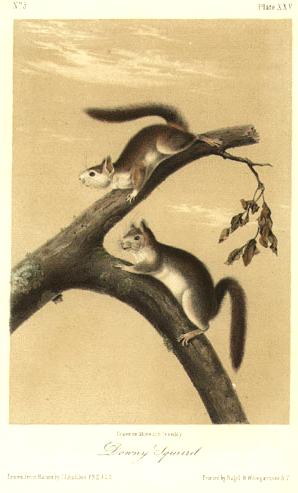

25 Downy Squirrel
SCIURUS LANUGINOSUS.--BACHMAN.
[Tamiasciurus hudsonicus lanuginosus (subspecies)]
DOWNY SQUIRREL.
[Red Squirrel]
PLATE XXV.
S. auribus brevibus, cauda subdisticha; S. Hudsonico paullo robustior,
supra castaneo-fuscus, subtus albus, naso concolori; lateribus argenteis;
occipite maculo distincto.
CHARACTERS.
Ears, short; tail, sub-distichous; light chesnut-brown on the upper
surface; sides, silver-gray. A spot on the hind part of the head, nose, and
under surface of body, pure white. A little stouter than S. Hudsonius.
SYNONYME.
SCIURUS LANUGINOSUS, Bach., Jour. Acad. Nat. Sc. of Phila., vol viii.,
pt. 1, p. 67, 1838.
DESCRIPTION.
Head, broader than in S. Hudsonius; forehead, much arched; ears, short and
oval; whiskers, longer than the head; feet and toes, short; thumb, armed with a
broad flat nail. Nails, compressed and acute; the third, on the fore-feet,
longest.
The tail, (which bears some resemblance to that of the flying squirrel, P.
volucella) is clothed with hairs a little coarser than those on the back, and is
much shorter than the body. On the fore-feet the palms are nearly naked, the
under surface of the toes being only partially covered with hair; but on the
hind-feet, the under surface from the heel to the extremity of the nails is
thickly covered with soft short hairs. Fur, softer and more downy than that of
any other of our species. The fur indicates that the animal is an inhabitant of
a cold region.
COLOUR.
Teeth, dark orange; whiskers, brown; fur on the back from the roots to near
the tip of the hair, light plumbeous, tipped with light chesnut-brown; on the
sides tipped with silver-gray. A broad line of white around the eyes, a spot of
white on the hind part of the head, a little in advance of the anterior portion
of the ears; nose, white, which colour extends along the forehead over the eyes,
where it is gradually blended with the colour of the back; the whole under
surface, feet, and inner surface of the legs, pure white. Tail, irregularly
covered with markings of black, light brown, and white, scarcely two hairs being
uniform ill colour.
In general it may be said that the tail, when examined without reference to
its separate hairs, is light-ash at the roots of the hairs, a broad but not well
defined line of light rufous succeeding, then a dark brown space in the hairs,
which are tipped with rufous and gray.
DIMENSIONS.
Inches. Lines.
Length of head and body . . . . . . . . . . . 7 11
Length of tail (vertebrae) . . . . . . . . . . 4 8
Length of tail, including fur . . . . . . . . . 6 0
Palm, and middle fore-claw. . . . . . . . . . . 1 0
Sole and middle hind-claw . . . . . . . . . . . 1 9
Length of fur on the back . . . . . . . . . . . 0 7
Height of ear, measured posteriorly. . . . . . . . 0 5
Distance between the orbits . . . . . . . . . . 0 6
HABITS.
This downy and beautifully furred squirrel exists in the north-western
portions of our continent. The specimen from which our drawing was made, is the
only one which we have seen, and was brought from near Sitka, by Mr. J. K.
TOWNSEND, who kindly placed it in our hands, in order that we might describe it.
As the animal was presented to Mr. TOWNSEND by an officer attached to the
Hudson's Bay Company, and was not observed by him, he could give us no account
of its habits. We think, however, that from its close approximation to that
group of squirrels of which the Hudson's Bay, or chickaree squirrel, is the
type, and with which we are familiar, we can form a pretty correct judgment in
regard to its general characteristics, and we will venture to say that it is
less agile and less expert in climbing than the chickaree; it no doubt burrows
in the earth in winter like the latter species, and as its tail is more like
that of a spermophile than the tail of a squirrel, although the rest of its
specific characters are those of the true squirrels, we are disposed to consider
it a closely connecting link between these two genera, and it very probably,
according to circumstances, adopts the mode of life commonly observed in each.
GEOGRAPHICAL DISTRIBUTION.
This species is found several degrees to the north of the Columbia river,
and is said to extend through the country adjoining the sea-coast as far as into
the Russian settlements. Mr. TOWNSEND says, "It was killed on the coast near
Sitka, and given me by my friend, W. F. TOLMIE. Esq., Surgeon of the Honourable
Hudson's Bay Company."
|